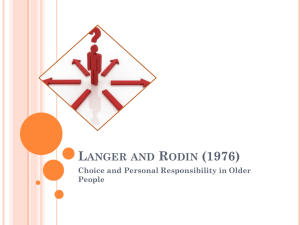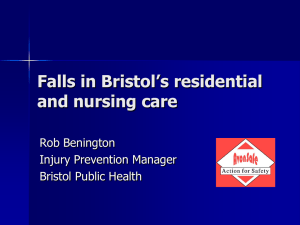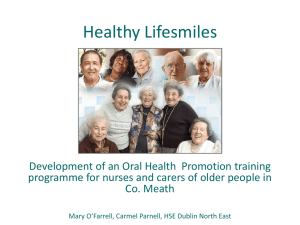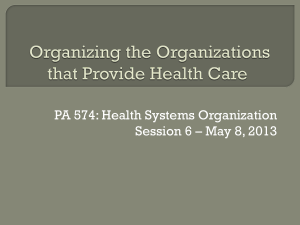Response to planning application
advertisement
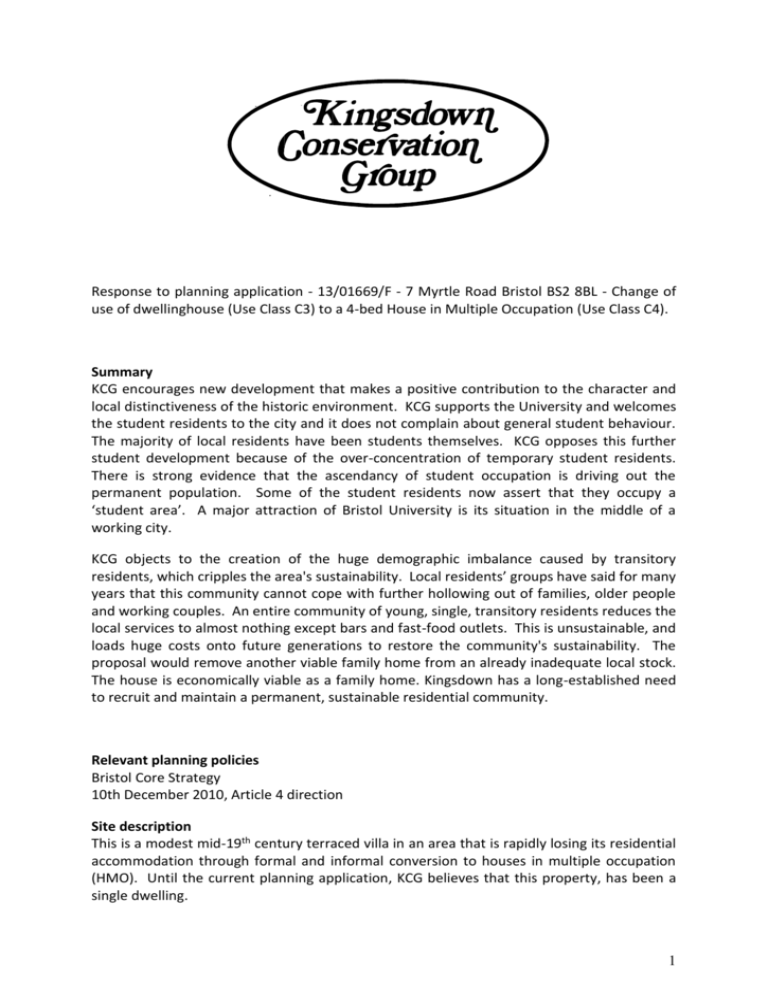
Response to planning application - 13/01669/F - 7 Myrtle Road Bristol BS2 8BL - Change of use of dwellinghouse (Use Class C3) to a 4-bed House in Multiple Occupation (Use Class C4). Summary KCG encourages new development that makes a positive contribution to the character and local distinctiveness of the historic environment. KCG supports the University and welcomes the student residents to the city and it does not complain about general student behaviour. The majority of local residents have been students themselves. KCG opposes this further student development because of the over-concentration of temporary student residents. There is strong evidence that the ascendancy of student occupation is driving out the permanent population. Some of the student residents now assert that they occupy a ‘student area’. A major attraction of Bristol University is its situation in the middle of a working city. KCG objects to the creation of the huge demographic imbalance caused by transitory residents, which cripples the area's sustainability. Local residents’ groups have said for many years that this community cannot cope with further hollowing out of families, older people and working couples. An entire community of young, single, transitory residents reduces the local services to almost nothing except bars and fast-food outlets. This is unsustainable, and loads huge costs onto future generations to restore the community's sustainability. The proposal would remove another viable family home from an already inadequate local stock. The house is economically viable as a family home. Kingsdown has a long-established need to recruit and maintain a permanent, sustainable residential community. Relevant planning policies Bristol Core Strategy 10th December 2010, Article 4 direction Site description This is a modest mid-19th century terraced villa in an area that is rapidly losing its residential accommodation through formal and informal conversion to houses in multiple occupation (HMO). Until the current planning application, KCG believes that this property, has been a single dwelling. 1 The key issue - would the proposed change of use to a HMO acceptable in principle? National and local planning justifies KCG's objection. Policy BCS5 (housing) explains the delivery of objectives 1, 2 and 4 of the Core Strategy at paragraphs: 4.18.1 This policy will ensure that new residential development provides for a range of housing types to help support the creation of mixed, balanced and inclusive communities. 4.18.4 …………………………. The increasing concentration of flats at high densities in certain parts of the city may not provide opportunities for families. 4.18.7 The policy criteria will help to achieve an appropriate mix of housing in all new residential development. Schemes will be expected to take account of housing need and demand, to have regard to the composition of the local housing stock and demographic changes and to respond to site related issues through imaginative design solutions…… On the 10th December 2010, the Council passed a direction under Article 4 of the Town and Country Planning (General Permitted Development) Order 1995 to direct that article 3 shall not apply to development consisting of the change of use of a building to a house in multiple occupation within an area, which includes 7 Myrtle Road. The officer’s report to the committee gave these reasons why permitted development of HMOs would harm the area: “HMO concentrations are having a negative impact on residential amenity and character within a number of the city’s central wards; Housing mix issues including household and housing size/tenure imbalances have been identified within a number of the city’s central wards; Exercise of permitted development rights within a number of the city’s central wards would undermine objectives to protect residential amenity and character and to create or maintain mixed communities;” Appendix A summarised the evidence to support the direction. The evidence in the appendix showed Cotham top the table with the most fulltime Bristol University or UWE student residents at 4,708 and Cabot to be third with 2,956 students. The report says that Officers will have better estimates of HMOs when 2011 census data becomes available. The report concluded “Existing HMO concentrations are having adverse impacts in certain areas which require some level of planning intervention. The High Kingsdown estate is one of the streets that the report identified as having the particular problems that it described.” 7 Myrtle Road abuts the boundary of the heavily student populated High Kingsdown estate. KCG request that the planning officer asks the Private Sector Housing Team to provide further information in respect of existing unlicensed and licensed HMOs in the immediate area. When these HMOs are mapped it will be clear that this is an area of the city where HMOs are highly concentrated. As such, the proposal will have an unacceptable effect the balance and mix of housing in the area. This would also add to problems raised by 2 neighbours of noise and disturbance from the `studentification' of the area. The economic and social problems that justified the local intervention to disapply some general development rights apply to this scheme. The council identified that the High Kingsdown estate suffered from the negative impact on its residential amenity and character caused by an over concentration of student occupants before the current planning application. 50% of the housing of the High Kingsdown estate is student occupied. The student occupation rate of the Holly Court flats on the High Kingsdown estate is higher because the owners advertise the block as student accommodation. KCG invites the Private Sector Housing Team to provide information in respect of existing unlicensed and licensed HMOs in the immediate area from information in the council’s possession to include returns for exemption from Council Tax and from the electoral returns. There is overwhelming local evidence to show that the probable occupants will be students because: • Bristol University is the scheme’s neighbour. • 50% of the surrounding residential accommodation is student occupied. KCG understands that the council must decide every planning application on its own merits. However, it draws attention to the decision in planning application No. 10/02852/F – 1 Woodfield Road, Redland. On the 23rd July 2010, the council refused an application to change a dwellinghouse to multi-occupancy under the policies of the Bristol Local Plan (1997). The Core Strategy has given the council greater powers of planning intervention where it considers that over-concentration of a particular use, harms an area. KCG distinguishes the decision made at appeal in Appeal Ref: APP/Z0116/A/12/2176229 Kings Arms, High Kingsdown against a refusal to grant planning application - 11/04527/F. That development proposed is conversion and extension of a former uneconomically viable public house to student cluster flats. the proposal did not result in the loss of existing family housing and further student colonising High Kingsdown houses. Planning balance In his decision in the planning appeal, the Inspector made clear at paragraph 29 that the public house conversion scheme was a very different entity from organic, unsupervised, unmanaged and disparate process of HMO colonisation. That development, he said, would bring a valued but long neglected local historic building back into active economic use and, on that basis would not conflict with policy BCS18 of the Bristol Civic Society. Unlike the appeal application, this planning application would reduce the stock of family housing. It would intensify the current harmful imbalance between the area’s shared and family accommodation. Planning conclusion A planning permission would exacerbate accelerate the loss of family homes and compromise the delivery of local commercial and community services in the locality. A planning permission would further reduce the range of housing types and increase the concentration of HMOs with a transient population and would reduce the area’s capacity to support a mixed and sustainable community. 3 Satisfactory provision for refuse and recycling storage has not been addressed. A HMO household will have very different requirements to that of a family home. Enhanced storage and recycling facilities are required for this number of residents. The area has some of the highest concentrations of HMOs so a refusal should not be hardly surprising because the levels of activity associated with the new use would be far greater than the existing use and be a detriment of the area's residential amenity. This planning application should be refused. 4
